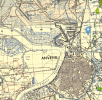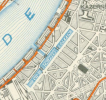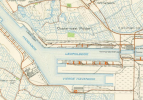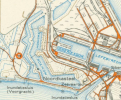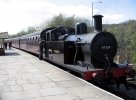The historic city of Antwerp lies 80 Km from the North Sea on the Scheldt River. The river Scheldt flows into the Dutch Schelde called Westerschelde. On the northern embankment of the Scheldt (Schelde) lies Noord Brabant, then the South Beveland and Walcheren peninsulas. The port is one of the Europe's great harbors, but it is not a natural harbor. Its docks were dug out and fitted with locks to regulate the water and allow transportation of goods further inland. Following D-Day, June 6, 1944, the Allies had enormous resources while German materials were shrinking. During the early days of the assault in Normandy, the German forces had managed to limit the supplies and ammunition that could come ashore by keeping the front narrow and denying the Allies the use of any of the French ports. American forces captured Cherbourg on June 27, 1944, but the Germans had done such an efficient job of demolition that the port did not open until July 19, 1944.
Following "Operation Cobra" the German positions in Normandy gave way. Racing to the Seine, the Allies were met at Mortain by a German counter-attack on August 6, 1944. The Allies used the opportunity to surround the German forces in the “Falaise Pocket,” destroying thousands of vehicles and killing or capturing more than 10,000 German troops. By August 25 the battle was ended and Paris was liberated the same day. German resistance west of the Seine River collapsed. Allied armies pushed forward in pursuit, crossing the river before the Germans could reorganize. The rapid movement of the Allied troops meant they were getting farther away from their supply lines. These supplies were still offloading in Normandy, over 500 miles distant. This led to shortages in critical supplies such as fuel and ammunition. British and American forces were forced to ration the resources—something that was very disagreeable to both.
The importance of the port to the Allies can be summed up in a message Eisenhower wrote to General Marshall on October 23, 1944 stating that "the logistical problem has become so acute that all plans had made Antwerp sine qua non to the waging of the final all-out battle." At the time, US Army doctrine called for the use of railways to transport large amounts of cargo whenever possible. However, because Allied bombers had destroyed so much of the French rail system during 1943-44, this wasn't possible. As the Allies worked to repair the railroads, supplies were being landed, but they were being stockpiled on the beaches and docks in Normandy. This backlog led to the implementation of a short-term fix using trucks to operate one-way circular routes to supply US troops. Several trucking operations were formed, one of which was the famous "Red Ball Express." In total, 141 truck companies were called, but there were not enough trucks available.
www.facebook.com


![ostyn-antwerp-map[1].jpg ostyn-antwerp-map[1].jpg](https://www.railforums.co.uk/data/attachments/150/150575-a3a8f266b4c3e7fcef9efb8848a18cd0.jpg)
![scheldt-map[1].jpg](/data/attachments/150/150577-2fc7e376aa4efc5667e28f3eb12c2b7a.jpg)
